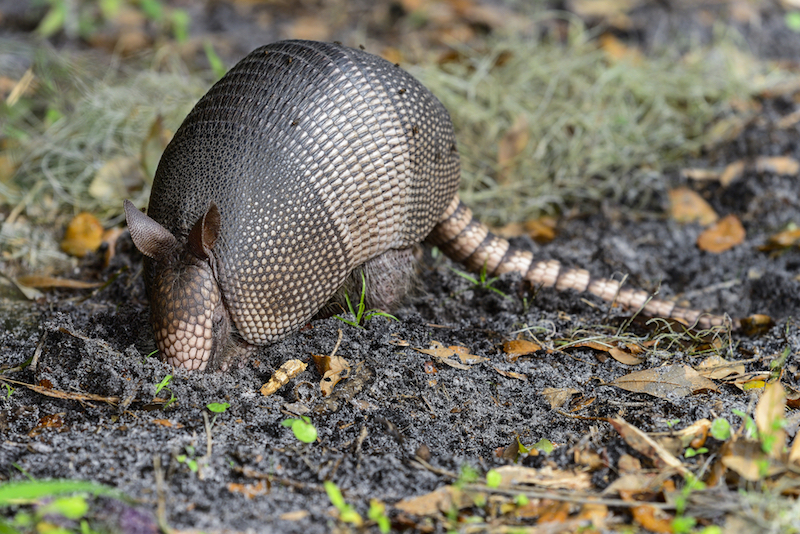Armadillos Carrying Leprosy Bacteria Spreading in Southern US

The armadillos in the southern United States carrying the bacteria that can cause leprosy are now found over a much larger geographic range than just a few years ago, a new study suggests.
The nine-banded armadillos that can transmit the bacteria Mycobacterium leprae to humans were once thought to be primarily confined to parts of Louisiana and Texas. However, now there's evidence that some of the animals with this infection live in other regions in the southeastern United States, said the paper, published online (Oct. 29) in the journal Emerging Infectious Diseases.
Leprosy — which is usually called by its modern name, Hansen's disease — is curable with antibiotics, and has a low risk of being spread among people.
"This is not a public health threat," said Richard W. Truman, chief of the laboratory research branch for the National Hansen's Disease Program in Baton Rouge, Louisiana, and the study's lead author. "Leprosy is and will remain a very rare infection," he told Live Science. [10 Deadly Diseases That Hopped Across Species]
Still, the finding shows that the area of the United States where people may be exposed to the bacteria is larger than thought, and may be still increasing in size, Truman said.
In the study, researchers tested bacteria in 645 armadillos from eight locations in four states — Alabama, Florida, Georgia and Mississippi — between 2003 and 2012. The researchers found armadillos infected with M. leprae in each location, according to the study.
About 16 percent of all the armadillos screened showed some evidence of infection, even though these areas had all previously been thought to be free of infected armadillos, the study found.
Get the world’s most fascinating discoveries delivered straight to your inbox.
However, the potential for the spread of leprosy between armadillos and humans is extremely low, Truman said.
Most people are immune
Only a small number of people, about 5 percent of the population, are susceptible to infection with the bacteria. The infection primarily affects the skin and nerves, and can cause symptoms such as skin lesions, nerve damage and deformity if not detected and treated early.
Studies have found that 95 percent of people are immune to the bacteria; even if people are exposed to these germs, they do not get sick.
Somewhere between 150 and 250 new cases of leprosy are diagnosed in the United States each year, Truman said. In a previous study, his research found that as many as 40 new cases of leprosy in the United States per year seem to be associated with exposure to infected armadillos, he said.
In the new study, the researchers compared the gene sequences of the bacteria from 42 of the infected armadillos to those from 52 people who developed leprosy between 2007 and 2012 in the same geographic region. M. leprae had not been found in this region before 2009, according to the study.
The researchers found that most of the infected armadillos carried the same strain of bacteria that had previously been linked with probable transmission to humans. Additionally, the investigators identified a different strain of M. leprae in armadillos in southern Florida, which may have infected several leprosy patients in that area. [7 Devastating Infectious Diseases]
None of the patients who were interviewed remembered having any direct contact with armadillos, but the patients could have had contact through gardening or other outdoor activities, such as hunting, fishing or tramping through a swamp, the researchers said.
How Hansen's disease may spread
The more common method of transmission of Hansen's disease is long-term direct contact with an infected person who has not been treated, typically someone who has traveled to a tropical country where the disease is more prevalent. The bacteria can spread through the air from one person to another, Truman said.
People who consume armadillos for food, who hunt the wild animals and prepare them for cooking, seem to be more at risk for the infection, Truman said. Avoiding direct contact with the blood or tissue of armadillos is an important element in decreasing exposure to the bacteria, he said.
"Most people are immune to becoming infected with Hansen's disease, and most armadillos don't have the bacteria that can cause" the illness, said Dr. David Scollard, director of the National Hansen's Disease Program Laboratory Research Branch, who was also involved in the study.
"There's no reason to become hysterical about seeing an armadillo," he said.
Since the 1940s, antibiotics have been used to cure Hansen's disease, and even more effective medications are available today, Scollard told Live Science. It was only before this time period that the disease was incurable, and that doctors could not prevent the infection from advancing, he said.
Hansen's disease is not a highly contagious disease, but most people have an image of leprosy as it's been depicted in movies and books, Scollard said. Today, the disease is no longer the curse people have imagined it to be, he said.
Follow Live Science @livescience, Facebook & Google+. Originally published on Live Science.
Cari Nierenberg has been writing about health and wellness topics for online news outlets and print publications for more than two decades. Her work has been published by Live Science, The Washington Post, WebMD, Scientific American, among others. She has a Bachelor of Science degree in nutrition from Cornell University and a Master of Science degree in Nutrition and Communication from Boston University.


